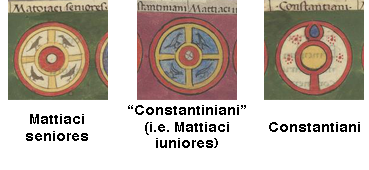
This page created 5 May 2014, and last modified: 7 June 2014 (some links added)

In the Eastern half of the empire, the fourth unit of auxilia palatina unit listed under the command of the second Master of the Soldiers in the Imperial Presence is the Constantiniani, just as the fourth unit under the the command of the first Master of the Soldiers in the Imperial Presence is the very similarly-named Constantiani. The shield pattern of the Constantiniani as shown in various manuscripts is as below:

The pattern shows what might best be described a yellow four-spoked wheel with a red rim/tyre, a red wheel hub, and a white axle, with the spaces between the four spokes being blue, and each featuring a bird, possibly a magpie. It is thus very similar to that of the Mattiaci seniores under the the command of the first Master of the Soldiers in the Imperial Presence, which is the same except for white spaces in place of the blue spaces (although they are in fact blue in the Froben edition, B).
A comparison of the unit names under the two Masters of Soldiers in the Imperial Presence, coupled with an examination of their patterns, makes it apparent that this shield pattern seems to belong not to the Constantiniani but the Mattiaci iuniores (see also under the Mattiaci seniores for further discussion) - the shield patterns for all four units in the first row of the second page of patterns for the Magister Praesentalis II are all misplaced. The following patterns taken from the Paris manuscript show the relationships:

Given the similarities in the paired patterns between the two Magistri, we might expect the pattern of the Constantiniani be be similar to that of the Constantiani. Unfortunately, none of the other units under the under the command of the magister Praesentalis II looks particularly similar. Nonetheless, that ascribed to the Tubantes, is somewhat similar: both share an apparent imago at the top, both have a large yellow boss, and both have a pillar beneath the boss. But the overall impression isn't very similar, on account of the different ground colours, the lack of differentiated boss and shield rims in the Tubantes, and the lack of spotting. So, all-in-all, suggestive, but hardly case proven.
The name would appear to derive from either Constantine I (the Great) or Constantine II, his son (whereas the Constantiani would appear to derive from either Constantius Chlorus, father of Constantine I, or Constantius II, another of his sons), but the name need not be directly derived: many places were named after members of the dynasty, and some units may have taken their names from being stationed at such a place (e.g. see the Prima Flavia Gallicana Constantia for one such example).

Return to the Notitia alphabetical unit list page.
Return to my Notitia index page.